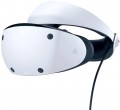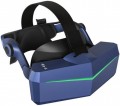Screen resolution
Resolution of built-in displays in glasses equipped with such equipment — that is, models for PC / consoles, as well as standalone devices (see "Intended use").
The higher the resolution, the more smooth and detailed the “picture” is given out by glasses, all other things being equal. Thanks to the development of technology nowadays, models with Full HD (1920x1080) screens and even higher resolutions are not uncommon. On the other hand, this parameter significantly affects the cost of points. In addition, it is worth remembering that in order to fully work with high-resolution displays, you need powerful graphics capable of playing relevant content. In the case of glasses for PCs and set-top boxes, this puts forward corresponding requirements for external devices, and in standalone models you have to use advanced integrated video adapters (which affects the cost even more).
Field of view
The viewing angle provided by virtual reality glasses is the angular size of the space that falls into the user's field of view. Usually, the characteristics indicate the size of this space horizontally; however, if you need the most accurate information, this point needs to be specified separately.
The wider the viewing angle — the more the game space the user can see without turning his head, the more powerful the immersion effect and the less likely that the image will be subject to the "tunnel vision" effect. On the other hand, making the field of view too wide also does not make sense, given the characteristics of the human eye. In general, a
large viewing angle is considered to be an angle of 100° or more. On the other hand, there are models where this indicator is 30° or even less — these are, usually, specific devices (for example, drone piloting glasses and augmented reality glasses), where such characteristics are quite justified given the overall functionality.
Refresh rate
The refresh rate supported by the glasses' built-in screens, in simple terms, is the maximum frame rate that the screens are capable of delivering.
Recall that screens are provided in models for PC / consoles and in stand-alone devices (see "Intended use"). And the quality of the picture directly depends on this indicator: other things being equal, a
higher frame rate provides a smoother image, without jerks and with good detail in dynamic scenes. The flip side of these benefits is an increase in price.
It is also worth considering that in some cases the actual frame rate will not be limited by the capabilities of the glasses, but by the characteristics of the external device or the properties of the content being played. For example, a relatively weak PC graphics card may not be able to pull out a high frame rate signal, or a certain frame rate may be set in the game and not provide boosting. Therefore, you should not chase after large values and
points with a frequency of 90 fps will be enough.
Pupillary distance adjustment
The ability
to adjust the interpupillary distance of glasses — that is, the distance between the centers of two lenses. To do this, the lenses are mounted on movable mounts that allow them to be moved to the right / left. The meaning of this feature is that for normal viewing, the centers of the lenses must be opposite the user's pupils — and for different people, the distance between the pupils is also different. Accordingly, this setting will be useful anyway, but it is especially important for users of a large or petite physique, whose interpupillary distance is noticeably different from the average.
At the same time, there is a fairly significant number of glasses that do not have this function. They can be divided into three categories. The first is devices where the lack of adjustment for the interpupillary distance is compensated in one way or another (for example, by a special form of lenses that does not require adjustment). The second is models where this adjustment is not needed in principle (in particular, some augmented reality glasses). And the third — the simplest and cheapest solutions, where additional adjustments were abandoned to reduce the cost.
USB A
The glasses must have at least one USB A connector. This is a full-sized USB connector, the same type as standard USB ports on computers and laptops. But its functions may be different, depending on the functionality of the glasses (see "Purpose"). So, in models for PCs and consoles, USB is one of the connection connectors used in conjunction with a video interface such as HDMI or DisplayPort: an image is transmitted via a video connector, and data from sensors on glasses is transmitted via a USB connection, which is necessary to change the picture and create " immersion effect. And in independent devices, USB A is used to connect various additional accessories — for example, flash drives with applications or other content. It is also possible to use this connector to charge the battery, although this method of use in general is not typical for it.
DisplayPort
Availability of
DisplayPort input in glasses; the version of this interface can also be specified here.
DisplayPort is one of the most popular high-resolution digital video interfaces these days (however, audio transmission is also possible). It is especially common in computer technology, and is actually a standard in Apple PCs and laptops. Only glasses for computers and set-top boxes are equipped with this type of input (see “Purpose”) - it is used to receive a video signal (and audio signal, if necessary) from an external device. As for DisplayPort versions, the options here could be:
- v.1.2. The earliest (2010) version that is relevant today, but at the same time a more than functional version. Fully supports video quality up to 5K (30 fps), and with certain restrictions - up to 8K.
- v.1.3. Update released in 2014. It provided the opportunity to fully work with 8K resolutions at 30 fps, and with 4K and 5K at 120 and 60 fps, respectively.
- v.1.4. Updated in 2016, in which the bandwidth was further increased - up to support for 5K video at 240 fps and 8K at 120 fps. In addition, there is compatibility with HDR 10 technology, which improves color reproduction and overall picture quality.
HDMI
Availability of HDMI input in glasses; the version of this interface can also be specified here.
HDMI is the most common interface for high-definition video and multi-channel audio today; it is widely used in both computers and video equipment. In VR glasses, this type of connector is responsible for receiving video and audio signals from an external device; accordingly, only models for PC / consoles have such a connector (see "Intended use"). As for HDMI versions, the options may be as follows:
— v.1.4. The earliest of the current standards, the 2009 model (with subsequent updates). Allows you to work with Full HD video at a frame rate of up to 120 fps, but with 4K content, the speed is limited to 24 fps.
— v.2.0. Standard introduced in 2013. Also known as HDMI UHD, thanks to full support for UltraHD 4K (provides frame rates up to 60 fps). And in further updates of this standard, support for HDR was added.
— v.2.1. Version released to the market in 2017. It allows you to achieve a frame rate of 120 fps even at 8K resolutions, not to mention more modest ones. HDMI Ultra High Speed cables are required for full use, but the features of earlier versions are available with regular cables.
Headphones
The presence
of your own headphones in the design or delivery of virtual reality glasses.
A full-fledged "immersion" in the virtual world requires not only a picture on the screen, but also an appropriate sound accompaniment, for which headphones are the best option. However, glasses take up quite a lot of space on the head, and not all “ears” can be comfortably combined with them (this is especially noticeable on large over-ear headphones). In addition, when connecting headphones with a wire, there may be problems related to the length and/or location of the audio cable. Thus, some models provide this function. These models can have any purpose (see above); most of these are for PC/console glasses, but headphones are also popular in standalone devices. Also note that some glasses use speakers located in the ear area; such speakers are also considered headphones in this case.
An alternative to the bundled "ears" is a headphone output; however, there are models with both functions at once — either folding / removable cups or the simplest speakers mentioned above play the role of headphones in them.
Control
The type of control provided in the design of the glasses.
Note that in this case we are talking exclusively about our own controls installed directly on the body of the glasses; many models are equipped with external controllers (see "Remote control"), but they are not taken into account in this case.
- Button. Control with classic buttons. The main advantage of this option is simplicity and low cost, while its functionality is quite enough to work with basic functions like menu navigation. On the other hand, the buttons require some effort when pressed, which can be somewhat inconvenient, especially when using the controls intensively. However, most often this disadvantage is still not fundamental.
- Touch. Control using sensors that are sensitive to touch and do not require pressing (unlike buttons). In the simplest models, these are separate sensors, the functions of which are similar to the same buttons. In more advanced devices, entire touch panels can be provided, for example, allowing you to control the cursor visible through the glasses and use special gestures. Anyway, this type of control is more advanced than push-button, however, it is more expensive, and therefore less common.

